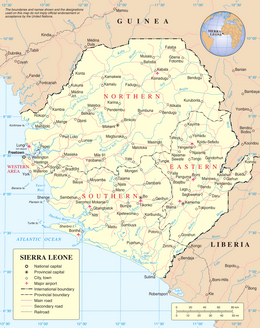Operation Barras
| Operation Barras | |||||||
|---|---|---|---|---|---|---|---|
| Part of the Sierra Leone Civil War | |||||||
 A map of Sierra Leone on which is marked Freetown (the capital, to the extreme west) and the nearby towns of Hastings (where the SAS and Paras prepared for the operation) and Masiaka (where the Jordanian detachment of UNAMSIL was based) |
|||||||
|
|||||||
| Belligerents | |||||||
|
|
West Side Boys | ||||||
| Commanders and leaders | |||||||
|
|
Foday Kallay (POW) | ||||||
| Strength | |||||||
| Approximately 150 | Approximately 100–200 | ||||||
| Casualties and losses | |||||||
| 1 killed, 12 wounded | At least 25 killed; 18 captured | ||||||
Operation Barras was a British Army operation that took place in Sierra Leone on 10 September 2000, during the late stages of that nation's civil war. The operation aimed to release five British soldiers of the Royal Irish Regiment who had been held by a militia group known as the "West Side Boys". The soldiers were part of a patrol that was returning from a visit to Jordanian peacekeepers attached to the United Nations Mission in Sierra Leone (UNAMSIL) at Masiaka on 25 August 2000 when they turned off the main road and down a track towards the village of Magbeni. There the patrol was overwhelmed by a large number of heavily armed rebels, taken prisoner, and transported to Gberi Bana on the opposite side of Rokel Creek.
The British Army negotiated the release of six of the eleven men on the patrol, but were not able to gain the freedom of their Sierra Leone Army liaison officer and the other men before the West Side Boys' demands became increasingly unrealistic. Negotiators concluded that these were delaying tactics rather than an effort to resolve the crisis; by 9 September, the soldiers had been held for over a fortnight. Fearing that the soldiers would be killed or moved to a location from which it would be more difficult to extract them, the British government authorised an assault on the West Side Boys' base, to take place at dawn the following day, 10 September.
The ground operation was conducted by D Squadron, 22 Regiment Special Air Service—who assaulted Gberi Bana in a bid to extract the Royal Irish—and elements of 1st Battalion, Parachute Regiment (1 PARA), who launched a diversionary assault on Magbeni. The operation freed the five soldiers as well as twenty-one Sierra Leonean civilians who had been held prisoner by the West Side Boys. At least twenty-five West Side Boys were killed in the assault, as was one British soldier, while eighteen West Side Boys—including the gang's leader, Foday Kallay—were taken prisoner and later transferred to the custody of the Sierra Leone Police. Many West Side Boys fled the area during the assault, and over 300 surrendered to UNAMSIL forces within a fortnight.
...
Wikipedia
